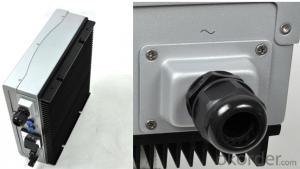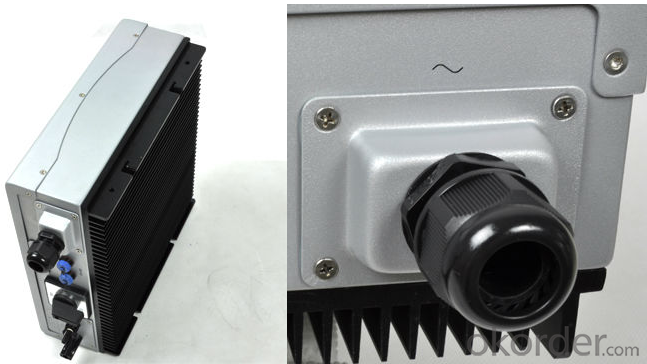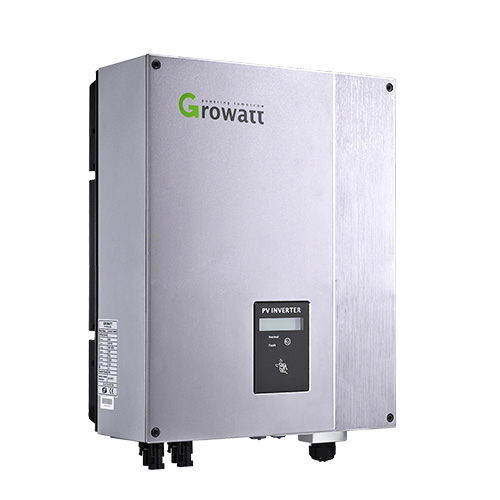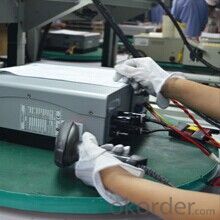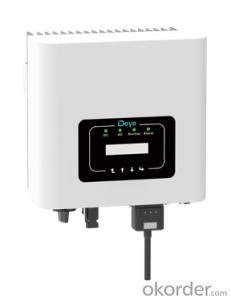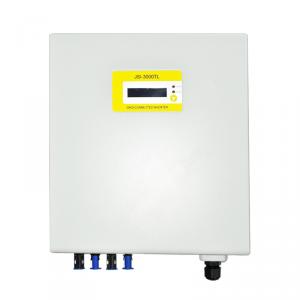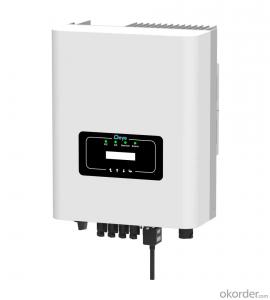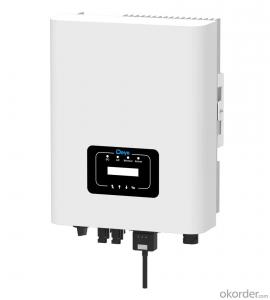Solar Inverter Price 2500MTL-3000MTL 2MPPT, Single Phase
- Loading Port:
- Shekou
- Payment Terms:
- TT or LC
- Min Order Qty:
- 10 pc
- Supply Capability:
- 100000 pc/month
OKorder Service Pledge
OKorder Financial Service
You Might Also Like
Solar inverter 2500MTL-3000MTL 2MPPT, single phase
Specifications
Maximum efficiency of 98% and wide input voltage range
Internal DC switch
Transformerless GT topology
Multi MPPT
Solar inverter General Descriptions
Leading-Edge Technology
> Maximum efficiency of 97.9 % and wide input voltage range
> Muti MPP controller
> Internal DC switch
> Transformerless H6 topology
> Compact design
> Muti MPP control
> MTL-String
> Bluetooth technology
> Easy installation
> Sound control
Europe /Australia ENS
> Simple national setting of line supply monitoring (ENS)
> Easy country configuration
> Muti-language display
> Currently available for Germany,France,UK,Austria,Switzerland,Italy and Spain
Solar inverter Communications
> RS485 /RS232/GPRS interfaces
> Computer monitoring software
Safety
> Full protection functions:DC reverse polarity, AC short-circuit protection, ground fault monitoring, grid monitoring, integrate all-pole sensitive, leakage current monitoring unit.
> Standards complied: SAA, CE/TUV, EN50178, VDE 0126-1-1,IEC 62109,RD 1663,G83,EN 61000-6-1,EN61000-6-2 ,EN61000-6-3,EN61000-6-4, DK5940, G83, RD1663, VDE-AR-N415, CEI 0-21

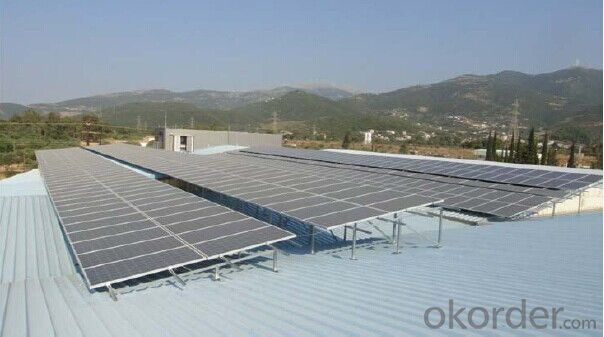
Technical Specifications
Model | 2500MTL | 3000MTL |
INPUT DATA | ||
Max. DC Voltage | 500V | 500V |
PV voltage range | 200V~500V | 200V~500V |
MPP Voltage Range | 200V~450V | 200V~450V |
Max. DC Power | 2700W | 3200W |
Max. Input Current | 10A/10A | 10A/10A |
Number of MPP Trackers/ | 2/1 | 2/1 |
Strings Per MPP Tracker | ||
OUTPUT DATA | ||
Nominal AC Output | 2500W | 3000W |
Max.Output Current | 12.5A | 15A |
Grid Voltage Range | 180~280V | 180~280V |
Rated Grid Frequency | 50Hz/60Hz | 50Hz/60Hz |
Output Current THD | < 3% | < 3% |
AC connection | Single phase | Single phase |
SYSTEM | ||
Max. Efficiency | 97.50% | 97.50% |
Euro. Efficiency | 97.00% | 97.40% |
MPPT efficiency | 99.50% | 99.50% |
Protection Degree | IP65(outdoor) | IP65(outdoor) |
Operating Temperature | -25~+60°C | -25~+60°C |
Cooling Method | No fan | No fan |
Display | LCD | LCD |
Standard Comm. Interfaces | RS485/RS232 | RS485/RS232 |
Optional Comm. Interfaces | GPRS/blue tooth | GPRS/blue tooth |
MECHANICAL DATA | ||
Dimensions(WxHxD) | 360/510/188mm | 360/510/188mm |
Net Weight | 15.6kg | 15.6kg |
Solar inverter FAQ
1. Have any design tool and how to use it?
Shine Design is the system design software just for inverters, It can conduct installers to figure out panel numbers for a system, panel numbers for each string, and which inverter model is suitable for the system. Moreover, it can print a design report after input all necessary parameters, can calculate DC/AC wire wastage, annual generation, etc.
2. Does the inverter have monitoring solutions for residential system?
For small rating system, we have wired two monitoring solution (ShineNet via RS232 or RS485). (a) Local wireless monitoring solution (ShineVision via RF module communication) (b) Global wireless monitoring solution (WIFI module via WIFI network)
3. Do you have free solution for monitoring?
ShineNet is an inverter monitoring software run in Windows XP, Windows Vista, Windows 7 operating system. It can monitor inverter via RS232 (or RS232 convert to USB cable) and RS485 wire connection. Customers can purchase the cable locally to get the inverter monitored, it is simple.
- Q: What are the different types of solar inverters?
- There are three main types of solar inverters: string inverters, microinverters, and power optimizers.
- Q: Can a solar inverter be used with solar-powered recreational vehicles (RVs)?
- Yes, a solar inverter can be used with solar-powered recreational vehicles (RVs). A solar inverter is an essential component of an RV solar power system as it converts the direct current (DC) generated by the solar panels into alternating current (AC) that can be used to power various appliances and devices in the RV. It helps optimize the energy generated by the solar panels and ensures a reliable power supply while on the move.
- Q: Can a solar inverter be used with a solar-powered air conditioning system?
- Yes, a solar inverter can be used with a solar-powered air conditioning system. A solar inverter is responsible for converting the direct current (DC) produced by solar panels into alternating current (AC) that can be used to power appliances. In the case of a solar-powered air conditioning system, the solar inverter enables the AC produced by the solar panels to be used by the air conditioning unit. This allows for the efficient use of solar energy to power the air conditioning system, reducing reliance on the grid and promoting sustainability.
- Q: What is the role of a frequency regulation feature in a solar inverter?
- The role of a frequency regulation feature in a solar inverter is to maintain a stable and consistent frequency of the electricity being generated by the solar panels. This is important because the electrical grid requires a specific frequency for efficient and reliable operation of electrical appliances and devices. The frequency regulation feature in a solar inverter ensures that the electricity generated by the solar panels is synchronized with the grid's frequency, thereby enabling seamless integration and optimal utilization of solar power.
- Q: How does a solar inverter handle shading or partial panel obstructions?
- A solar inverter handles shading or partial panel obstructions by utilizing maximum power point tracking (MPPT) technology. This technology allows the inverter to constantly monitor each individual solar panel's output and adjust the voltage and current to maximize power production. If shading or obstructions occur on one or more panels, the inverter can dynamically optimize the output of the unshaded panels, ensuring maximum efficiency and power generation despite the partial loss of sunlight.
- Q: How does a solar inverter handle grid faults and disturbances?
- A solar inverter is designed to handle grid faults and disturbances by continuously monitoring the grid conditions. In the event of a fault or disturbance, such as a voltage or frequency fluctuation, the solar inverter will quickly disconnect from the grid to ensure the safety of the system. Once the fault is resolved and the grid conditions stabilize, the solar inverter will reconnect to the grid and resume normal operation, ensuring a reliable and stable power supply.
- Q: How does a solar inverter handle shade on solar panels?
- A solar inverter handles shade on solar panels by utilizing a technology called maximum power point tracking (MPPT). MPPT allows the inverter to constantly monitor the output of each individual solar panel and adjust the voltage and current to maximize the power production. When shade is detected on a solar panel, the inverter automatically reduces the power output of the affected panel, ensuring that the shaded area does not significantly impact the overall performance of the system.
- Q: What is the role of a power control feature in a solar inverter?
- The role of a power control feature in a solar inverter is to regulate the flow of electricity between the solar panels and the electrical grid. It ensures that the solar energy generated by the panels is efficiently converted and synchronized with the grid's voltage and frequency. Additionally, it helps maintain a stable and consistent power output, maximizes energy production, and protects the system from overloading or damage.
- Q: Are there any safety considerations when installing a solar inverter?
- Yes, there are several safety considerations when installing a solar inverter. Firstly, it is important to ensure that the inverter is installed by a qualified professional who is familiar with local electrical codes and regulations. This helps to minimize the risk of electrical hazards and ensures a safe installation. Additionally, proper grounding and bonding should be implemented to protect against electrical shock and lightning strikes. Adequate ventilation and temperature management are also important to prevent overheating and potential fire hazards. Overall, following safety guidelines and employing professional installation services are crucial to ensure the safe and efficient operation of a solar inverter system.
- Q: How does a solar inverter provide ground fault protection?
- A solar inverter provides ground fault protection by continuously monitoring the flow of electricity between the solar panels and the electrical grid. If it detects any abnormal or excessive current leakage to the ground, it quickly shuts off the flow of electricity to prevent electrical hazards, such as electric shocks or electrical fires.
Send your message to us
Solar Inverter Price 2500MTL-3000MTL 2MPPT, Single Phase
- Loading Port:
- Shekou
- Payment Terms:
- TT or LC
- Min Order Qty:
- 10 pc
- Supply Capability:
- 100000 pc/month
OKorder Service Pledge
OKorder Financial Service
Similar products
Hot products
Hot Searches
Related keywords
